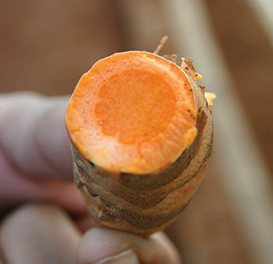Growing, Harvesting, and Manufacturing Curcumin

Curucmin is a compound from the rhizomes of turmeric (Curcuma longa), and belongs to the same family as ginger. India is the largest commercial producer of turmeric, and has around 100,000 acres of it under cultivation, harvesting about 100,000 tons per season.
Turmeric thrives in hot, tropical climates with light soil. The plant is propagated by dividing the rhizomes, so it’s important to hold enough back from each season’s crop to plant again. It is a very hardy plant, and like all botanicals, its yield of compounds depends greatly on where it is grown and under what kind of conditions.
For example, some turmeric root has only a very low percentage of curcumin content – about 2 to 5 percent, while others have as much as 6 to 8%. Farming techniques and local climate can make a big difference.
The plant itself can grow to about a meter in height, and has been used in food and medicine for thousands of years throughout southern Asia.
As part of an overall worldwide trend towards sustainable farming practices, there are some turmeric growers who use only natural fertilizers, work by hand, and carefully rework any extra plant material back into the soil.
The farmers here use traditional, sustainable methods to improve the quality of their turmeric crops. They use natural fertilizers (animal manure), dig the turmeric roots and rhizomes, burn the leaves and till the ash back into the soil as additional fertilizer. The work is done by hand, involving no modern machinery. Turmeric is an important crop in this region. Careful attention is paid to the plants using regular and optimum irrigation, and sustainable and eco-friendly cultivation.
The underground part of the plant – the rhizome – is yellow-brown with a dull orange interior that brightens to a bright yellow when dried and powdered. The rhizomes are about an inch in length, and will begin to smell unpleasant if stored too long.
The Spice Board of India
Advances in turmeric farming occur all the time. The Spice Board of India (a governmental agency) and the Agriculture Department assist farmers in improving their cultivation, conservation, and harvesting techniques. These agencies promote a balance between age-old botanical know-how and the best current practices of working with the soil and supporting community development.
Curcumin Extracts for Research and Supplementation:
For much of the supplemental market (and used by much of the existing research) curcumin is extracted from turmeric and standardized to contain 95% curcuminoids. The process can differ between manufacturers, but overall the results are a high percentage of curcumin that is not always well absorbed by the body. In fact, much of the research on curcumin has cited this concern as one of the primary roadblocks to therapeutic usage.
That’s because standardized curcumin still remains a large particle size. Although the cumulative effects of turmeric consumption may overcome that a bit (a possible reason for lower Alzheimer’s disease in India), it is still a problem for anyone seeking help for a given health concern.
Because of this, there have been various ways that researchers and manufacturers have tried to boost absorption. Some of the most recognized are:
Blending with Piperine:
Piperine – the compound from black pepper (Piper nigrum) that is responsible for its pungency makes the ingredient highly absorbable, but may interfere with common prescription medications. It is fine for short term use, but check with your physician before using long-term.
Blending with Phosphatidylcholine:
Phosphatidylcholine provides a safe transporter of curcumin, but may not always show the blood retention time required for therapeutic uses.
Micronizing and blending with turmeric oil:
Micronizing – making a standardized curcumin a very small particle size and then reblending with natural turmeric oil – shows excellent absorption and blood retention time, but the process is expensive, which is noticeable in the retail price.
Using Nanotechnology:
Nanotechnology is a very new method and may provide very high levels of absorption, but it is not a thoroughly tested method in humans and its safety profile is relatively unknown.
Extracts and Classes of Solvents
Responsible supplement manufacturers use safe solvents to extract botanical compounds. However, not all solvents are the same.
Solvents are graded based on their potential toxicity. When something is called a “class 1” solvent, that means it contains known or strongly suspected human carcinogens, and should definitely be avoided in any and all pharmaceutical manufacturing. (Benzene and carbon tetrachloride are two examples.)
Class 2 solvents are inherently toxic and should be either avoided altogether or only used in very limited circumstances. They include hexane, chlorobenzene, and trichloroethylene.
Class 3 solvents are the mildest and safest, and pose no human health hazard risks. They include ethanol (alcohol), acetic acid (known to most in its diluted form, vinegar), and of course, water – the universal solvent you’d use for that coffee or tea – both of which are, in a sense, homemade extracts.
The potential risks with Class 1 and 2 solvents are serious, and can lead to brain damage, kidney failure, or even cancer. The problem is that solvent residue can be left behind in food, supplement, or pharmaceutical products.
Consider Your Options
If you are considering trying a curcumin supplement, one of the best things you can do is research these methods, and find the approach that you feel comfortable with and seems to work best for your regimen.

